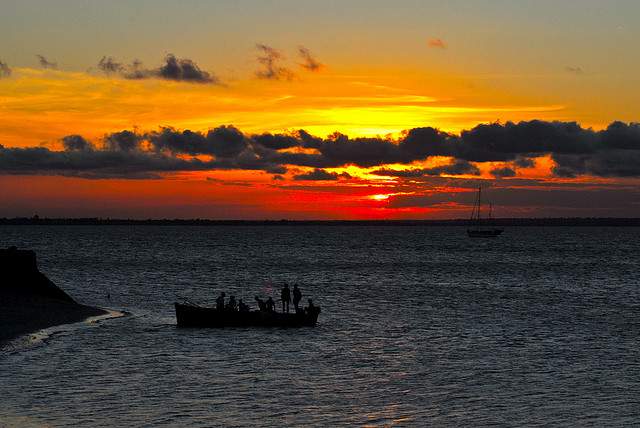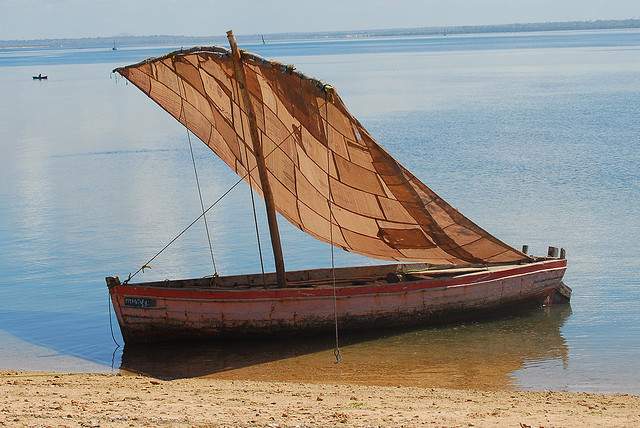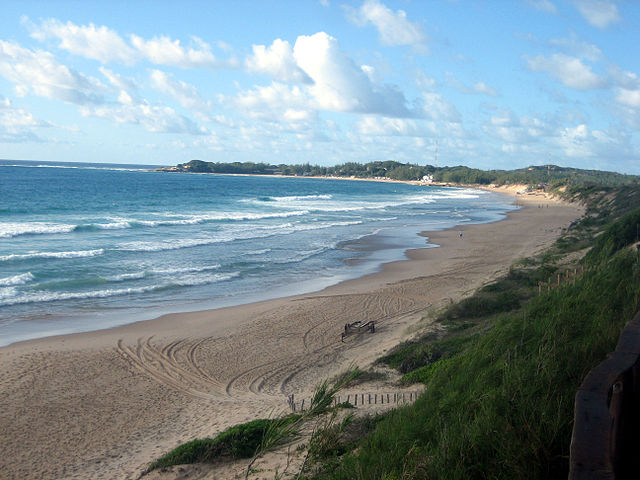Mozambique used to be one of Africa’s best-kept secrets, partially due to a 20-year guerrilla war. But now the hard times have passed, and what has emerged is a country with so much untapped potential. Mozambique has some of the most beautiful beaches and best diving and off-the-beaten-path adventures that Africa has to offer. Live your dream of captaining your own ship as you sail on a dhow between Mozambique’s many uninhabited islands, go snorkeling and diving in its crystal clear waters, or simply relax on its pristine beaches.
We chose the $45 per person, per day number after personal experience and research. From dormitories to private rooms, accommodation is easy to find, and while it is not the cheapest place out there, the rewards of pristine views, awesome nightlife, and great activities is well worth the extra cash. Hostels are by far the easiest way to save on accommodation, and if you are willing to bring your own tent, many charge a reduced rate to set it up on their grounds. A dorm usually ranges between $10-15USD per night, but almost always includes sheets and a mosquito net. If a you are venturing into Africa solo, then Mozambique is perfect; the increasing influx of travelers makes it super easy to find a travel buddy, shared accommodation is common, and almost all hostels have lively common areas. This budget also assumes that public buses will be your main mode of transportation.
Mozambique’s enormous coastline means one thing when it comes to cuisine: fresh seafood, and plenty of it. It is incorporated into a number of dishes, either fresh, smoked or dried. Mozambique’s food is influenced by its interesting history of Bantu, Swahili, and Portugese populations. Spicy stews accompanied by rice or steamed cornmeal dough are common local dishes. You will never go a day without eating some fruit variation, as oranges and grapefruits, bananas, mangoes, and coconuts are ever present.
When it comes to activities, I didn’t say “No” to anything because of cost – I experienced everything there was to experience. From exploring Maputo’s diverse city streets to searching for Whale Sharks off the coast of Tofo, the suggested $45/person/day budget will allow you to do pretty much everything. Following is a breakdown of how you, too, can travel around Mozambique on $45 per day, and we’ll offer tips, advice, and practical information for those of you who want to do it on less and more than that.

Transportation
The transportation infrastructure in Mozambique, especially in the south, is surprisingly well developed compared to many other African countries; however, in the north connections become less reliable and roads are unkempt. One of the only routes where you will find luxury buses connects Maputo and Johannesburg, South Africa. The only other budget option is either mini-buses or pickup trucks, and these are relatively easy to find and travel many different routes (even to the most obscure locals). Private cars are available also; however, they are very expensive, so depending on your budget and desired comfort level, you have plenty of choices.
[social]
Getting in
Register for an account on Indie and start pricing and planning your trip to Africa!
You can enter Mozambique by several different methods:
- Plane: Maputo is Mozambique’s main hub for international flights, and several airlines fly here daily. It has a relatively decent regional network, including flights to Dar es Salaam, Johannesburg, Nairobi, as well as connections to Lisbon, Portugal. There are smaller airports in Vilankulos and Beira, which have regular flights to Maputo.
- Land: Mozambique shares its borders with several African countries: South Africa, Malawi, Tanzania, Swaziland, Zambia, and Zimbabwe. Some borders are significantly easier to cross than others, so plan accordingly:
To/From Malawi: There are several different options for crossing into Mozambique.
- Zobue connects Mozambique to Blantyre, Malawi, and is a pretty reliable crossing point. From Mwanza, transfer to a minibus that continues on to Tete (US$1.50).
- The Milange crossing is most convenient of you are traveling to or from Ilha de Mocambique. From Milange vila (town) itself you can usually find a minibus or truck to Mocuba (US$4), Quelimane and Nampula.
- At the Mozambique border crossing at Mandimba you will find connections to the border at Chiponde (US$3). On the Malawian side of Mangochi, you can hop on another minibus into the interior.
- From the Dedza border post, which is 85km southeast of Lilongwe, there is a sealed route that runs from Tete to Ulongwe. Make sure you arrange your Mozambique visa in advance, as there are no border services at this crossing.
**The first three options above are not for the faint of heart, as connections are iffy at best, tourists are nowhere to be seen, and travel is, to put it lightly, not comfortable**
- To/From South Africa: Transportation to South Africa is by far the easiest and most comfortable. Several bus companies run direct luxury coaches from Maputo to Johannesburg every day and cost between 30 USD to 40 USD. For destinations closer to the northern border, you have several different mini-buses transfers, bumpy rides, and long waits in your future.
**Make sure that you arrange your visa in advance if you are entering South Africa by bus, as the lines at immigration are horrifically long and the buses will not wait for your visa to be processed.**
- To/From Swaziland: Daily minibuses run from Maputo from Manzini via the Lomahasha/Namaacha border, which is open from 7am-8pm ($5 USD, 3½ hours). There are also several different hostels in both Swaziland and Mozambique that run shuttle services, mostly between Manzini, Maputo, and Tofo (23-55 USD). If you are driving your own car, the quiet border at Goba/Mhlumeni (open from 7am-6pm) is a good option.
- To/From Tanzania: From Mtwara there are daily pickups that leave at 6.30am to the Kilambo border post and on to the Rovuma River. Crossing here is not for the faint of heart – it is crossed via dugout canoe. On the other side, you can connect to two daily pick-ups to the Mozambique border post (4km away) and on to Moçimboa da Praia (10 USD, four hours). If you have your own car, a vehicle ferry at Kilambo operates at high tide several times weekly (US$50 per vehicle).
- To/From Zambia: Northwest of Tete, the main crossing is at Cassacatiza. Pickup trucks go daily from Tete to Matema, from where the transport to the border is random at best. There you can find daily vehicles to Katete (Zambia), and on to Lusaka or Chipata.
- To/From Zimbabwe: There is a well traveled route that links Harare with Blantyre, and the main crossing is along this route at Nyamapanda. From Tete to Changara takes about 1.5 hours and costs around $3 USD, and in Changara you can connect to minibuses going to Harare. The Machipanda border on the Harare-Beira route is another easy option. There are also through-buses that go to Harare via Blantyre if you are not interested in transferring multiple times. From Chimoio you can reach Manica and the border. From there take a taxi to Mutare, where you will find local Zimbabwe transport and can also connect to the night train to Harare.

- Boat: You can cross into Mozambique via Lake Malawi and the Ilala ferry. It stops at Cóbuè and Metangula weekly on its journey up the Lake Malawi coast toward Likoma Island. You can get your Mozambique visa at Cóbuè. There are also slow sailing boats that travel between Likoma Island, Cóbuè and Metangula.
Getting around
Travel in southern Mozambique is pretty easy, although not necessarily the most comfortable. There are regular connections to the beaches from Maputo, and you have a range of options in terms of comfort level. Interior and northern Mozambique is less developed and definitely more challenging to travel through as connections are unreliable and the roads are not well maintained. Larger but old local buses, mini-buses, and pickup trucks are pretty much all that is available to those on a budget. Taxis are available and not exorbitantly priced, especially if you are traveling in a group. Private cars are also available, but expensive.
- Bus: You will find several different bus transportation options. There are a few luxury buses that run to South Africa, and old, local beauties and mini-buses for internal trips. As a rule of thumb buses are always the fastest option (other than hiring a private car).
- Other than if you are going internationally, most of travelers choose to break up their travel in short spurts up the coast. There are so many little beach towns and picturesque villages to visit that to skip all the way across the country without stopping to visit would be a shame. In addition, most of the overnight buses are international, so you would lose a day in travel anyways.
- Smaller mini-buses and pickup trucks traverse shorter distances (we’re talking 4 hours instead of 12) and are definitely the most cost effective way to get around, even if not the most comfortable.
- Bicycle: Several tourist agencies in more popular tourist locations rent bicycles, and this can be a great way to explore the surroundings at your own pace.
- Air: While Maputo is the hub, there are also smaller airports in Beira and Vilankulos. If you are pressed for time, (and have a higher budget), it might make sense to fly from Maputo to one of these locations in order to save the hours spent on local buses. The flights are quick and reasonably priced.
- Rental: It is not recommended to rent cars in Mozambique because the roads are in questionable condition, the locals drive aggressively, and the signage is basically non-existent.
- Boat: There are tons of opportunities to travel by water. Mozambique’s 2500km coast is ripe for water adventures, and various travel agencies offer trips of different lengths.
Transport costs

- First-class bus ride: The cost of first class buses is relatively reasonable. For example, the overnight trip from Maputo, Mozambique to Johannesburg, South Africa costs anywhere from $30-40 USD.
- Minibus or pickup truck: This is by far the most affordable method of transportation in Mozambique. A typical 3-hour bus journey costs $5-6 USD.
- Air: Airfare is always changing, but it is always the most expensive form of internal transportation.
Accommodation
When it comes to accommodations in Mozambique, you have a variety of options ranging from camping, to shared dorms, to exclusive high-end hotels. Southern Africa in general is more expensive than, for example, Central America or Southeast Asia, and unfortunately Mozambique is no exception.
Camping is a great way to save money, so if you are not picky about a hard floor or a few bugs, this is the way to go. Otherwise, you can get a clean, comfortable dorm room starting at around $12 USD, or you can you can up your spend and get a really nice hotel. Most of the hostels in Mozambique include linens and mosquito nets and have attached bars or restaurants. A private single room in a hostel or small guesthouse will put you back about $25 USD, while a slightly higher budget of $45-70 USD/night will get you a decent sized, clean double room. Anything that costs upwards of $100USD/night is going to be great quality, but if you want real luxury you are looking at upwards of $300 USD.
Some of the exclusive resorts are brand new and amazing, but are not suited for budget travelers. I averaged about $12 USD per night when I was in Mozambique (on the days I was not camping), and I always stayed in shared dorms. For a single traveler dorms are definitely the best option because it was much easier to meet others, and left extra budget for adventures.
- $8-$10: A campsite (you have to bring your own tent) and access to hot showers and electricity.
- $12-$15: A bed in a comfortable dormitory, with mosquito nets and linens included. This is the cheapest option besides camping and is recommended for single travelers, as well as those with a tight budget.
- $15–$25: This budget will get you a private single room with a shared bathroom, a fan, mosquito net, and linens included.
- $30-$70: With this budget you can expect a simple double private room, breakfast in some places, clean quarters, and a private bathroom. On the higher end of this budget you will have more space, air-conditioning, and possibly internet.
- $100-$150: Spending over $100-150 USD per night will get you a beautiful hotel room, possibly with a view, breakfast, air-con, and Wi-Fi.
- 300+: Mozambique has some amazing luxury resorts, but to stay there you have to shell out the big bucks. If you do, you will be rewarded with enormous rooms, gorgeous views, star services, pools, butlers, and spas, etc.
Food

Mozambique has 2500km of coastline, so fish is an integral part of their cuisine, and it is fresh and delicious. Fish is used in many different dishes and cooked in a variety of ways, including smoked and dried. Mozambique’s culture is quite interesting as it has both European and traditional African roots, so its food is different from other African countries.
Local restaurants have more character, so take a step off the beaten path and venture into a local spot and try a flavorful stew with the traditional steamed cornmeal dough, followed by some fresh fruit for dessert. Snacks of the fried persuasion are also easy to find. Try the curry samosas that children sell on the beach for about 25 cents a pop – they are deliciously flavorful and an easy and cheap way to satiate those mid-day hunger pains without having to go to a full-blown restaurant.
There is a robust drinking culture in Mozambique. Maputo has tons of clubs and bars, and jazz is also super popular. The beach towns are not lacking in the beach-bar scene, especially more touristy spots like Tofo. The bars are always well stocked and are great places to meet and hang out with locals.
Highlights

Are you an adventure seeker? Mozambique’s 2500km coast is practically undiscovered territory ripe for the picking. Take a safari in the wilds of Gorongosa National Park, explore the cobbled streets and stately colonial buildings on Ilha de Mocambique, or if you are really looking for excitement, head inland into the Mozambiquen northern highlands. Here you feel like the only person in the world, with expanses so large they seem to engulf you, and vistas so impressionable that they seem from another world.
If you are really looking for excitement, head inland into the Mozambiquen northern highlands. Here you feel like the only person in the world, with expanses so large they seem to engulf you, and vistas so impressionable that they seem from another world.
City-goer? You’re in the right place. Maputo is a lively bustling metropolitan center with great restaurants and a happening nightlife. People-watch while sipping an espresso at one of its busy sidewalk cafes, wander the streets and pick up some local handicrafts in its sprawling markets, visit one of its many jazz bars and experience local music, or dance until the sun rises at a disco.
- Tofo – White sand dunes that lead to pristine waters and kilometers of deserted beaches is what you will find in Tofo, along with a lively party atmosphere and great accommodation. Dive or snorkel in its tropical waters and you will likely see manta rays, and even a possible whale shark.
- Montes Chimanimani – Tired of the sea? Here dense tropical forests hide secluded valleys. Visit here to encounter the rich traditional cultures of Mozambique.
- Maputo – This dynamic capital has everything you would expect from a bustling major city. Its beautiful tree-lined streets, popular sidewalk cafés and energetic nightlife with keep you entertained for days.
- Archipelago Barazuto – This island paradise has some of the most beautiful beaches in Mozambique. Be careful, because it is easy to lose track of the days here as you watch the sunset over turquoise waters.
Off the beaten path
While Mozambique is pretty popular on the Southern Africa tourist circuit, it is still easy to get off the beaten path.
- Take an inland trip. Most people are drawn to the idyllic beach towns, and few people venture into the inner parts of Mozambique. Here you can get an authentic local experience without the crowds of some of the more popular tourist locations.
- Take a safari in the Gorongosa National Park or sail on a dhow through mangrove channels in the Quirimbas Archipelago.
For more on traveling to Mozambique, check out the following articles:
- Read the Mozambique Indie Travel Guide
- Read 10 Unspoiled Beaches for Your RTW Trip
- Find a hostel in Mozambique
Photo credits: F H Mira, F H Mira, tonrulkens, rabanito, Erik Cleves Kristensen
